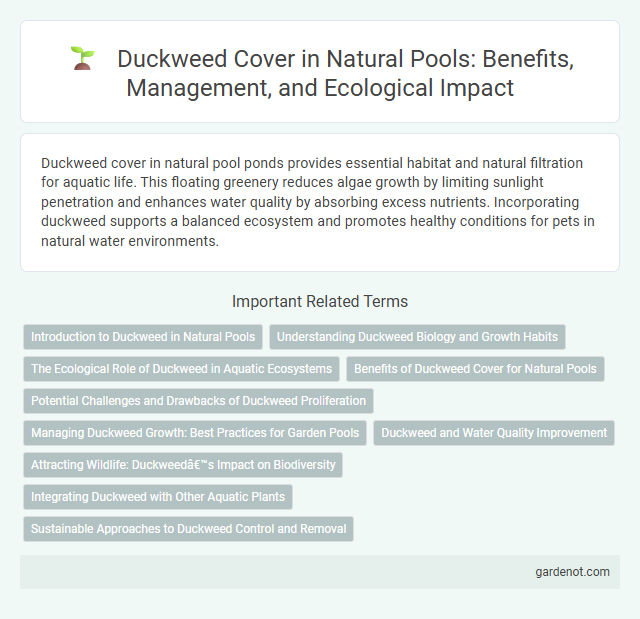Duckweed cover in natural pool ponds provides essential habitat and natural filtration for aquatic life. This floating greenery reduces algae growth by limiting sunlight penetration and enhances water quality by absorbing excess nutrients. Incorporating duckweed supports a balanced ecosystem and promotes healthy conditions for pets in natural water environments.
Introduction to Duckweed in Natural Pools
Duckweed, a small free-floating aquatic plant, plays a vital role in natural pools by providing a natural filtration system and habitat for beneficial microorganisms. Its dense mats effectively reduce sunlight penetration, helping to control algae growth and maintain water clarity. This fast-growing plant also absorbs excess nutrients, promoting a balanced ecosystem within the natural pool.
Understanding Duckweed Biology and Growth Habits
Duckweed (Lemna spp.) is a small, free-floating aquatic plant that rapidly covers the surface of natural pools due to its prolific vegetative reproduction. It thrives in nutrient-rich, calm waters and can double its biomass in just 2-3 days under optimal conditions, forming dense mats that impact light penetration and oxygen levels. Understanding duckweed's biology, including its preference for still, warm environments and nutrient uptake mechanisms, is essential for managing its growth in natural pools to maintain ecological balance.
The Ecological Role of Duckweed in Aquatic Ecosystems
Duckweed plays a crucial ecological role in aquatic ecosystems by providing surface cover that reduces sunlight penetration, which helps control algae growth and maintain water quality. This floating plant absorbs excess nutrients such as nitrogen and phosphorus, preventing eutrophication and supporting biodiversity by creating habitat for microorganisms and small aquatic species. Its rapid growth and natural filtration capacity make duckweed an important component for sustaining balanced and healthy natural pools.
Benefits of Duckweed Cover for Natural Pools
Duckweed cover in natural pools provides significant benefits including natural water filtration by absorbing excess nutrients and reducing algae growth, which enhances water clarity and quality. It creates a shaded habitat that helps regulate water temperature, protecting aquatic life and promoting biodiversity. The dense mat of duckweed also serves as a natural habitat for beneficial microorganisms and insects, supporting a balanced and healthy ecosystem.
Potential Challenges and Drawbacks of Duckweed Proliferation
Duckweed proliferation in natural pools can lead to oxygen depletion, negatively impacting aquatic life by reducing water aeration. Excessive duckweed cover may block sunlight penetration, hindering photosynthesis for submerged plants and disrupting the ecosystem balance. Moreover, dense duckweed mats can cause clogging of filtration systems and create maintenance challenges for pool management.
Managing Duckweed Growth: Best Practices for Garden Pools
Effective management of duckweed growth in garden pools involves regular physical removal and maintaining balanced nutrient levels to prevent excessive proliferation. Introducing aquatic plants like water lilies can create shade, reducing light availability and slowing duckweed expansion. Monitoring water quality parameters such as nitrogen and phosphorus concentrations helps maintain ecological balance, minimizing the risk of dense duckweed coverage.
Duckweed and Water Quality Improvement
Duckweed plays a critical role in natural pools by enhancing water quality through nutrient absorption and reducing algae growth. This small floating plant efficiently removes excess nitrogen and phosphorus, key contributors to water eutrophication, thereby maintaining clear and balanced aquatic ecosystems. Its dense cover also limits sunlight penetration, helping to suppress unwanted algal blooms and fostering healthier water conditions.
Attracting Wildlife: Duckweed’s Impact on Biodiversity
Duckweed cover enhances natural pools by providing essential habitat and food sources, attracting diverse wildlife such as amphibians, insects, and waterfowl. This floating plant supports ecosystem balance by offering shelter and breeding grounds, thereby increasing local biodiversity. Maintaining optimal duckweed density promotes a thriving aquatic environment beneficial for various species.
Integrating Duckweed with Other Aquatic Plants
Integrating duckweed with other aquatic plants in natural pools enhances water filtration and nutrient uptake, creating a balanced ecosystem. Combining duckweed with submerged plants like hornwort and emergent species such as cattails helps reduce algae growth by competing for sunlight and nutrients. This synergistic plant diversity improves water clarity and supports a healthy habitat for aquatic life.
Sustainable Approaches to Duckweed Control and Removal
Duckweed control in natural pools is effectively managed through sustainable approaches such as manual removal and the introduction of compatible aquatic plant species that compete for nutrients, reducing duckweed proliferation naturally. Utilizing biological controls like fish species that feed on duckweed helps maintain ecological balance without harmful chemicals. Incorporating aeration systems improves water circulation, limiting stagnant conditions that favor duckweed growth while promoting oxygen levels for healthier ecosystems.
Duckweed cover Infographic

 gardenot.com
gardenot.com